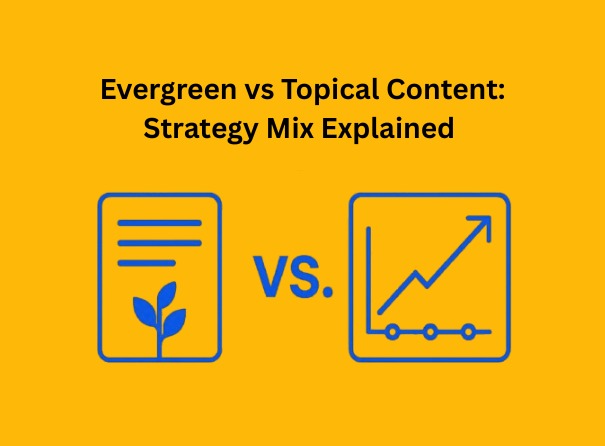Table of Contents
- What Is Evergreen Content?
- What Is Topical Content?
- Differences Between Evergreen and Topical SEO
- When to Use Evergreen Content
- When to Use Topical Content
- How to Balance Evergreen and Topical in One Strategy
- Conclusion

Table of Contents

TL;DR: The right mix of evergreen vs topical content can boost both long-term SEO and short-term engagement. Evergreen content delivers consistent value over time, while topical content captures timely traffic. A smart strategy blends both to keep your brand relevant and visible.
In today’s fast-paced content landscape, brands must do more than just publish—they must publish with purpose. Choosing between evergreen vs topical content isn’t about picking a side; it’s about mastering the art of timing, value, and consistency. While evergreen content steadily attracts traffic over time, topical content offers bursts of visibility aligned with trends and current events. For businesses building a sustainable strategy, this mix is crucial. Many companies rely on expert content marketing services to build an editorial calendar that leverages both formats effectively for long-term SEO performance and engagement.
Evergreen content refers to digital assets—blogs, videos, or guides—that remain relevant long after they’re published. These pieces are not influenced by seasonal changes or industry news. Instead, they focus on timeless topics such as tutorials, beginner’s guides, or educational posts. The strength of an evergreen content strategy lies in its ability to generate consistent traffic and leads without frequent updates. When structured properly with relevant keywords, internal links, and optimized meta descriptions, these articles often climb steadily in search rankings and remain high-performing for years.
Topical content, on the other hand, focuses on current events, trends, or seasonal topics. Its primary purpose is to capture attention in the now—bringing in immediate traffic and engagement. Topical content examples might include commentary on industry changes, reaction to breaking news, or posts tied to cultural moments and holidays. While its relevance fades faster, its impact can be powerful in positioning your brand as a real-time voice in your industry. For businesses looking to remain visible and responsive, topical content plays an important role in engagement and reach.
The debate of topical vs evergreen SEO boils down to longevity versus immediacy. Evergreen SEO focuses on long-term search visibility, allowing brands to build authority and generate passive traffic from search queries that don’t change often. These posts typically have low maintenance costs and deliver compounding value. Topical SEO, by contrast, aims to capitalize on surges in interest. Google prioritizes freshness for time-sensitive topics, so if you're publishing around new trends, you'll likely see short-term spikes. However, the content must be timely, accurate, and well-distributed to truly compete.
Brands should lean on evergreen content when developing a stable foundation for their website’s SEO performance. These pieces often support service pages, core brand messaging, and educational goals. Knowing when to use evergreen content is also about timing—such as when launching a new product or building cornerstone content. Evergreen articles work best in nurturing leads, supporting long-term conversions, and creating backlink-worthy resources. They are also easier to repurpose, whether as social snippets, downloadable guides, or email campaigns. They may not generate instant buzz, but their ROI grows over time.
Topical content thrives during time-bound moments—product launches, holidays, or major announcements. When you need visibility now, whether it’s to boost shares or respond to competitor activity, topical content is your go-to. It also works beautifully alongside timely promotions or brand initiatives. If you're looking to quickly scale engagement or align with search trends, topical content is ideal. And before choosing a partner, it’s worth exploring which content marketing agencies are going to rule the roost in 2025 to ensure your topical strategy stays sharp and relevant in a crowded space.
A well-balanced strategy combines both. The evergreen and topical content mix ensures that your brand remains both relevant and visible over time. Think of evergreen content as the roots of your SEO tree—deep, reliable, and slow-growing. Topical content, meanwhile, is the vibrant foliage that catches attention in the moment. To get the best of both worlds, create an editorial calendar that alternates between foundational topics and trend-driven opportunities. This also means setting aside time for content updates—transforming aging topical content into refreshed evergreen assets over time.
Beyond just publishing consistently, marketers must learn how to plan a content mix that aligns with business goals, SEO objectives, and audience intent. That’s why many businesses seek out strategic SEO Services that include content performance monitoring, keyword optimization, and periodic refreshes to maximize impact.
If you're new to digital campaigns, understanding how content builds B2B business is key to developing not just traffic—but trust and conversion.
Conclusion
The truth is, there’s no one-size-fits-all content approach. Brands that perform well in search and user engagement have learned to integrate both content types with intention. Whether you’re educating your audience or reacting to industry trends, your editorial decisions should align with business outcomes. While topical content helps you stay current, evergreen content builds a sustainable SEO engine in the background. Together, they create a powerful, balanced system that serves your audience’s needs—today and tomorrow.
At Inqnest Digital Marketing Agency, we specialize in crafting custom content strategies that combine the lasting value of evergreen content with the real-time relevance of topical pieces—designed to grow your visibility, traffic, and engagement in tandem.








